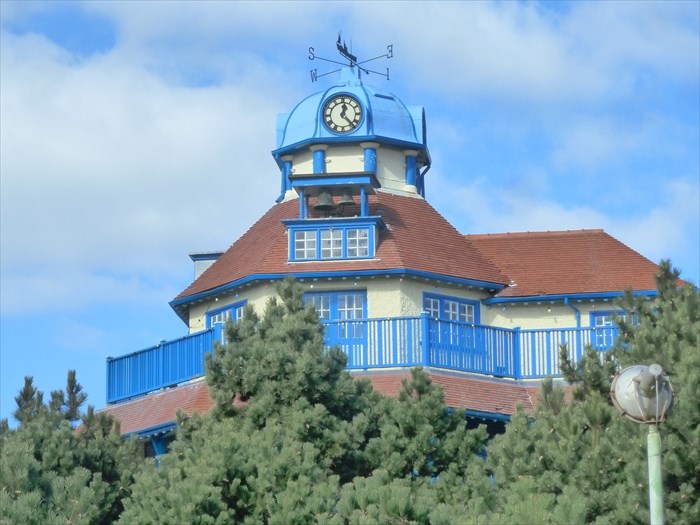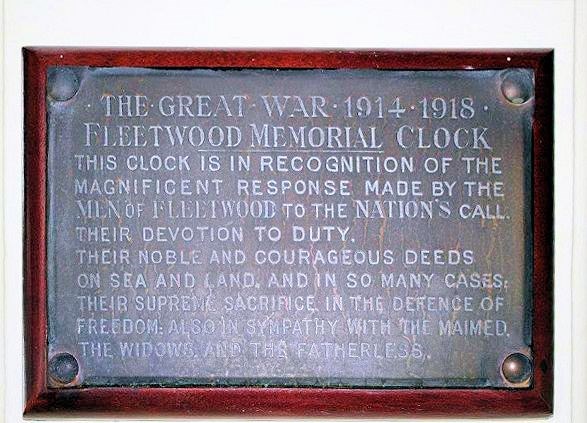
Known simply as The Mount, this is the highest point on the coastal town of Fleetwood, and the center hub from which streets radiate according to the original design by Decimus Burton who laid out the plans for the city in 1840. This pavilion was built in 1904 to replace an earlier structure which had resembled a Chinese Pagoda. In 1919 this clock was added, a gift by Isaac Spencer in tribute to Fleetwood veterans of World War I.

THE GREAT WAR 1914 1918
FLEETWOOD MEMORIAL CLOCK
THIS CLOCK IS IN RECOGNITION OF THE
MAGNIFICENT RESPONSE MADE BY THE
MEN OF FLEETWOOD TO THE NATION'S CALL.
THEIR DEVOTION TO DUTY.
THEIR NOBLE AND COURAGEOUS DEEDS
ON SEA AND LAND, AND IN SO MANY CASES,
THEIR SUPREME SACRIFICE IN THE DEFENCE OF
FREEDOM. ALSO IN SYMPATHY WITH THE MAIMED.
THE WIDOWS AND THE FATHERLESS.
The clock is mounted on the cupola which is painted bright blue and topped by a weather vane depicting a fishing trawler. The clock face features twelve Roman numerals on a round background. Hatch marks are used in the outer circle for the minutes and the hands appear somewhat thick.
Below the clock on the east side are two bells which chime on the quarter hour. When open to the public, the workings of the clock are visible as is the dedication plaque.
On June 30, 1989, The Mount Pavilion was given the Grade II listing as a British Listed Building with the following description:
Seaside pavilion. 1904. Roughcast brick; tiled roofs. Polygonal range with wing
attached to north. 2 storeys. Ground floor stall openings (probably original but
with modern steel roll-shutters) protected by pentice supported on square-section
posts with shaped brackets. Above the pentice a balcony runs around the entire
building (with simple wooden railings); 2 and 5-light casement windows at this level
with small glazing panes. The polygon is surmounted by a cupola with clocks at the
cardinal points. Dormers to roof slopes and a bellcote facing east. Wing with
hipped roof. A pretty, ornawental piece of Edwardian seaside architecture.
Listing NGR: SD3337348217
One of the best histories of The Mount is given by Michele Harris and Brian Hughes in the The Fylde and Wyre Antiquarian:
The Mount, once known as the ‘Starr Hill’ (after the type of grass growing on it) and also as ‘Tup Hill’ (a name related to the activities of the sheep here belonging to Duelacres Abbey) was, originally, the highest of the sand dunes on Fleetwood peninsula. Because of this it became the central hub around which Decimus Burton (an architect best remembered for his stupid name) designed the fishing port. The single-storey lodge that stands to this day at the entrance gates was used by Burton for his office.
The hill, itself, is unnatural in shape, having been formed most likely by some sort of obstruction, such as a tree stump or a rock, around which wind-blown sand very gradually accumulated.
As far as speculation goes, its history seems to have extremely ancient roots, with certain authorities, such as Thompson Watkin, believing it to have once been the site of a Roman watchtower, whilst others, such as Ben Edwards, reckon it might have been a Norman motte and bailey.
The Mount Pavilion was originally constructed in a ‘Chinese Pagoda’ style, and was known as ‘Temple View’ for reasons best left to those who feel the necessity to give buildings names. It was replaced in 1902 by the infinitely more dalek-like present structure. Isaac Spencer presented the clock on the Pavilion’s roof to Fleetwood in 1919, as a memorial to those killed in World War I.
In the 1840s Peter Hesketh, Fleetwood’s visionary founding father, built a cobbled wall around the Mount, proclaiming exclusive rights to a footpath here. Predictably, founding father or not, a riot ensured, angry residents kicking part of the wall down and forcing Hesketh to relinquish control.
The roads of Fleetwood were originally marked out using a plough, in the fashion of spokes on a cartwheel (or, at least, half a cartwheel) using the Mount as their central point. Rumour has it (and we really ought to emphasis the word ‘rumour’ here) that, in the 1980s, a deep Roman well was discovered somewhere on the Mount’s slopes. Being considered as dangerous it was immediately filled with rubble and grassed over. On slightly firmer historic ground, in 1945 a Wellington Bomber crashed into the sea in front of the Mount.
Some interesting historic photos and comments can also be found on the
The Mount, Fleetwood Blog.